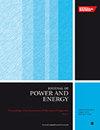纽科门热机作为低温余热热机的发展潜力评价
IF 1.1
4区 工程技术
Q3 ENGINEERING, MECHANICAL
Proceedings of the Institution of Mechanical Engineers, Part A: Journal of Power and Energy
Pub Date : 2023-05-16
DOI:10.1177/09576509231173476
引用次数: 0
摘要
从温度为80-150°C的低温废热中可以获得大量但大多未使用的能源。缺乏具有成本效益的技术阻碍了这一潜力的发电。为了解决这一问题,最近研制出了利用蒸汽的冷凝和产生的真空作为动力的冷凝发动机。它的简单性和使用水作为工作流体保证了成本效益。在这项工作的背景下,决定调查纽科门发动机,以评估其潜力。这种发动机通常被忽视,因为它的效率低,认为是由不断冷却和再加热气缸造成的。建立了发动机的热力学模型。令人惊讶的是,该模型表明,78%的热损失是由注入水的再加热引起的,只有22%是由气缸的冷却和再加热引起的。这一发现使得一种新型发动机——内部冷凝发动机的概念得以形成,这种发动机的气缸采用塑料材料,水的强制喷射将损失降到最低。与竞争对手的技术相比,这种发动机的效率相似或更高,同时更简单,因此更具成本效益。本文章由计算机程序翻译,如有差异,请以英文原文为准。
Assessment of the Newcomen engine’s development potential as heat engine for low temperature waste heat
There is a large but mostly unused energy resource available from low temperature waste heat with temperatures of 80–150°C. The lack of a cost-effective technology prevents the generation of power from this potential. Recently, the Condensing Engine, which employs the condensation of steam and the arising vacuum as the driving force, had been developed to address this problem. Its simplicity and the use of water as working fluid promises cost-effectiveness. In the context of this work, it was decided to investigate the Newcomen Engine to assess its potential. This engine is usually neglected because of is low efficiency, thought to be caused by the continuous cooling and re-heating of the cylinder. A thermodynamic model of the engine was developed. Surprisingly, the model indicated that 78% of the heat losses are caused by the re-heating of the injection water and only 22% by the cooling and re-heating of the cylinder. This finding allowed to conceptualise a new engine, the Internal Condensation Engine, where plastic material for the cylinder and the forced ejection of the water minimise losses. The engine would have a similar or better efficiency than competitive technologies whilst being simpler, and therefore more cost-effective.
求助全文
通过发布文献求助,成功后即可免费获取论文全文。
去求助
来源期刊

CiteScore
3.30
自引率
5.90%
发文量
114
审稿时长
5.4 months
期刊介绍:
The Journal of Power and Energy, Part A of the Proceedings of the Institution of Mechanical Engineers, is dedicated to publishing peer-reviewed papers of high scientific quality on all aspects of the technology of energy conversion systems.
 求助内容:
求助内容: 应助结果提醒方式:
应助结果提醒方式:


